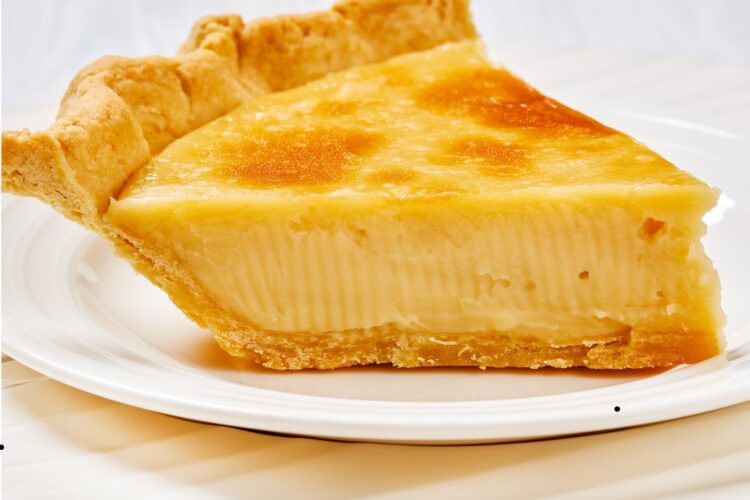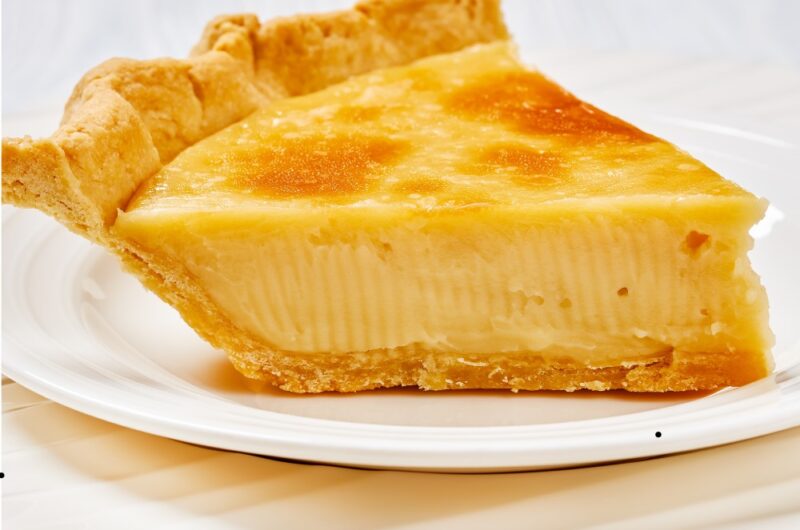Magic custard cake is a delightful dessert that surprises with its ability to form three distinct layers during baking. The top layer is a light, fluffy sponge cake, while the bottom layer is a dense, starch-based creation reminiscent of kueh. And what lies in the middle? A smooth, creamy custard that’s milky and irresistibly indulgent.
Jump to Recipe Print RecipeIf you loved my previous recipe for pandan kaya cake, you’ll find magic custard cake just as exciting. While pandan kaya cake is a delicious blend of cake and kueh, this recipe takes things a step further. Magic custard cake combines the textures of cake and kueh with the rich creaminess of custard—all in one dessert. Best of all, you don’t need to prepare the kueh or custard separately. Isn’t that amazing? It’s like having your cake and enjoying the kueh and custard too.
The Process of Baking Magic Custard Cake
Unfortunately, baking magic custard cake isn’t as simple as waving a wand and having a perfect dessert appear before your eyes. To achieve this culinary marvel, you’ll need to roll up your sleeves and use the separated egg method to prepare the batter.
The batter for magic custard cake is unlike any other. It contains an unusually large amount of milk, making it incredibly thin and watery. Because of this, you must use a one-piece baking pan to avoid leaks. A loose-bottom pan is a no-go, as the liquid batter will simply seep out before baking.
The magic of this cake lies in its ability to self-separate into three layers while baking at a low temperature. The ingredients interact in a way that allows them to settle into distinct layers over time.
Here’s how it happens:
- The Bottom Layer: Kueh
The starch in the flour naturally separates from the protein. Being heavier and denser, the starch sinks to the bottom of the pan, forming a firm layer with a texture that resembles kueh. - The Top Layer: Cake
Without the starch to weigh it down, the protein in the flour rises to the top of the pan, joining forces with the light, airy egg whites in the batter. Together, they create the fluffy sponge cake layer that crowns the dessert. - The Middle Layer: Custard
Sandwiched between the heaviest and lightest layers, the egg yolks create a luscious custard. This middle layer is the heart of the cake, offering a smooth, creamy texture that balances the denser kueh and the airy cake.
Tips for Perfect Magic Custard Cake
If you want to recreate this masterpiece, it’s crucial to follow the recipe closely. Don’t be surprised if your whisked egg whites—also known as meringue—appear slightly grainy. That’s exactly how they should look for this recipe to succeed.
Why is grainy meringue important? If the egg whites are too smooth and creamy, the cake layer will turn out excessively wet, even when the top is beautifully golden brown. This happens because smooth meringue contains too much water, which evaporates too slowly during baking.
On the other hand, if the meringue is overly grainy, the cake layer will be too thin. This is because egg whites that are too grainy lose their elasticity and don’t rise as much. A thin cake layer can’t absorb all the fat from the batter, leading to an undesirable layer of butter between the custard and cake.
It’s also important to avoid the opposite extreme: a cake layer that rises too much and becomes overly thick. A thick cake layer is often too wet and disrupts the delicate balance of textures in the dessert.

Striking the Perfect Balance
Achieving the ideal texture requires finding the Goldilocks sweet spot for your meringue—not too smooth, not too grainy, but just right. When you get it right, you’ll be rewarded with a cake layer that is light and fluffy, neither too thick nor too thin, and perfectly moist.
This balanced cake layer pairs harmoniously with the creamy custard and the dense kueh. The ratio of cake to custard and kueh is just right, creating a symphony of textures and flavors in every bite.
How to Get the Right Meringue
The key to perfect meringue lies in closely following the recipe. Every step matters, so it’s important to pay attention to details and avoid taking shortcuts. Do everything the recipe instructs, and avoid doing anything it doesn’t mention. Precision is key to achieving the desired results.
While you don’t need a magic wand to bake magic custard cake, you do need a reliable recipe and a bit of patience. With the right technique and ingredients, you can create this stunning dessert that showcases three distinct layers: fluffy cake, creamy custard, and dense kueh.
Why Magic Custard Cake Stands Out
What makes magic custard cake so special is its unique ability to offer three contrasting textures in a single bite. The combination of fluffy, creamy, and dense layers creates a dessert that feels like three treats in one. Whether you’re a fan of kueh, custard, or cake, this dessert has something to delight every palate.
The process of making magic custard cake is a testament to the wonders of baking science. By understanding how the ingredients interact during the slow baking process, you can create a dessert that feels almost magical. It’s a reminder that sometimes, the most impressive results come from the simplest ingredients and techniques.
Serving and Enjoying Magic Custard Cake
Once your magic custard cake is baked and cooled, it’s ready to be served. Dust the top with a light layer of powdered sugar for an elegant finishing touch. When you slice into the cake, you’ll see the three layers in all their glory, each distinct yet harmoniously combined.
Serve the cake as a dessert for special occasions or as a delightful treat to brighten an ordinary day. Its unique texture and flavor make it a crowd-pleaser, perfect for sharing with family and friends.
A Dessert Worth the Effort
While magic custard cake may require a bit of effort and attention to detail, the results are well worth it. The combination of cake, custard, and kueh offers a delightful medley of textures and flavors that’s sure to impress.
So, if you’re looking for a dessert that’s as enchanting as it is delicious, give magic custard cake a try. With the right recipe and a little patience, you’ll create a treat that’s nothing short of magical.
Magic Custard Cake
Course: DessertCuisine: AmericanDifficulty: Easy8
servings15
minutes50
minutes213
kcalIngredients
75 g icing sugar
45 g egg yolks
85 g unsalted butter melted and cool
12 g water
3/4 tsp vanilla extract
85 g plain flour
1/16 tsp salt
360 g full-fat milk slightly warm
105 g egg whites
20 g castor sugar
Directions
- Prepare the Cake Pan and Oven:
Fully line an 18 x 18 x 5 cm one-piece cake pan with a 30 x 30 cm sheet of parchment paper, leaving the corners uncut for a seamless fit. Preheat your oven to 160°C. Measure and prep all ingredients as listed for smooth workflow. - Prepare the Egg Yolk Mixture:
In a mixing bowl, sift the icing sugar. Add the egg yolks and whisk until the mixture turns a pale ivory shade. Incorporate the melted butter, water, and vanilla extract, whisking until the ingredients are fully combined. Sift the plain flour into the mixture, then add the salt. Whisk gently until the batter is evenly mixed. Pour in the milk and whisk until fully incorporated.
Ingredients for Egg Yolk Mixture:
75 g icing sugar
45 g egg yolks
85 g unsalted butter, melted
12 g water
3/4 tsp vanilla extract
85 g plain flour
1/16 tsp salt
360 g full-fat milk - Prepare the Meringue:
In a separate bowl, whisk the egg whites on high speed until they form a thick foam. Gradually add the castor sugar and continue whisking at high speed until stiff peaks form. You’ll know the meringue is ready when the peaks are straight (not hooked) and the texture is slightly grainy.
Ingredients for Meringue:
105 g egg whites
20 g castor sugar - Combine the Mixtures:
Gently fold the meringue into the egg yolk mixture. Use a whisk to mix until the two are fully combined. Scrape down the sides of the bowl with a spatula and give the batter a final mix to ensure everything is evenly incorporated. - Bake the Cake:
Pour the batter into the prepared cake pan, smoothing the surface with a spatula to level it. Bake in the preheated oven for approximately 50 minutes, or until the top is golden brown and the edges of the cake feel firm and springy when pressed lightly. - Unmould and Serve:
Remove the cake from the oven and carefully lift it out of the pan using the parchment paper. Serve immediately or at your preferred temperature: hot (use a serrated knife for clean cuts), warm, room temperature, or slightly chilled.

